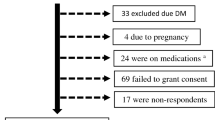Abstract
The incidence of ischemic heart disease is rising rapidly in many of the affluent Arab countries and it is known that hypercholesterolemia is a well established risk factor for coronary artery disease. This community-based study was undertaken to determine if elevated cholesterol is a problem in the United Arab Emirates in order to be able to evaluate the contribution of cholesterol as a risk factor for atherosclerosis in this environment. Volunteers were recruited at busy urban public sites. Data on age, sex, nationality, weight, blood pressure and smoking history were collected, and blood samples were taken for estimation of total cholesterol, hemoglobin and individual blood group. A raw data set was developed, with calculation of body mass index and subsequent statistical analysis carried out on a PC using the SPSS programme. In the 834 patients, there were 19 nationalities represented which were pooled into 7 groups (5 Arab and 2 non Arab) according to their ethnic origins. The prevalence of hypercholesterolemia varied from 47.2–53% in the Arab Nationals and from 22.7 to 44.5% in the non Arabs. The mean cholesterol levels of the Arab subgroups were similar and showed no difference, statistically. However, they were significantly higher than non Arabs, i.e. Indians (p<0.001) and Iranians (p<0.001). Similarly, within the Arab subgroups, the median cholesterol levels were no different but were higher than the non Arabs, i.e. Indians (p<0.05) and Iranians (p<0.001). No statistical difference was found in the distribution of cholesterol (high, borderline high or desirable levels) among the seven ethnic groups. Hypercholesterolemia appears to be a problem in most nationalities living within the UAE. Overall, it afflicts nearly 50% of the adult population. Although the ethnic Arab groupings have a wide range of socioeconomic attributes, the similarity of the distribution of cholesterol may point to an underlying innate genetic etiology or an environmental cause such as dietary overindulgence, or both. Urgent public health measures such as education, case finding and further screening programs are required.
Similar content being viewed by others
References
Frick MH, Elo O, Haapa K, et al. Helsinki Heart Study: Primary prevention trial with gemfibrizol in middle-aged men with dyslipidemia. N Engl J Med 1987; 317: 1237–1245.
Laurier D, Chau NP, Segond P, et al. Cholesterol and other cardiovascular risk factors in a working population in Ile-de-France: First results of the PCV-metra study. Eur J Epidemiol 1992; 8: 693–701.
Lipid Research Clinics Program. The Lipid Research Clinics Coronary Primary Prevention Trial results, I: Reduction in the incidence of coronary heart disease, II: The relationship of reduction in incidence of coronary heart disease to cholesterol lowering. JAMA 1984; 251: 351–374.
The Multiple Risk Factor Intervention Trial Research Group. Mortality rates after 10.5 years for participants in the Multiple Risk Factor Intervention Trial. JAMA 1990; 263: 1795–1801.
Keys A, Menotti A, Aravanis C, et al. The seven countries study: 2289 deaths in 15 years. Prev Med 1984; 13: 141–154.
Simons LA. Interrelations of lipids and lipoproteins with coronary artery disease mortality in 19 countries. Am J Cardiol 1986; 57: 5G-10G.
Inam S, Cumberbatch M, Judzewitsch R. Importance of Cholesterol Screening in Saudi Arabia. Saudi Med J 1991; 12 (3): 215–220.
Warnick GR. Measurement of cholesterol triglycerides, and HDL using compact analysis systems. Clinics in Laboratory Medicine 1989; 9: 73–88.
The Expert Panel. Report of the National Cholesterol Education Program, National Heart, Lung and Blood Institute. Report on the treatment of high blood cholesterol in Adults. Arch Intern Med 1988; 148: 36–39.
The Expert Panel. Summary of the NCEP Adult treatment Panel II Report. JAMA 1993; 269: 3015–3023.
Annual report. Mortality statistics in the UAE. Abu Dhabi, UAE: Ministry of Health, 1992.
Khoja SM, Salem AM, Taha AM, Hakim NA. Plasma lipid levels of a selected Saudi Arabian population in the western region. Saudi Med J 1993; 14 (4): 315–321.
Knuiman J, West CE, Burema J. Serum total and high density lipoprotein cholesterol concentrations and body mass index in adult men from 13 countries. Am J Epidemiol 1982; 116: 631–642.
Sempos C, Fulwood R, Haines C, Carrol M, Anda R, Williamson DF, et al. The prevalence of high blood cholesterol levels among adults in the United States. JAMA 1989; 262: 4445–4452.
Sox HC. Screening for lipid disorders under health reform system. New Engl J Med 1993; 328: 1269–1271.
Rifkind BM, Lippel K. Cholesterol screening. Clinics in Laboratory Medicine 1989; 9(1).
Author information
Authors and Affiliations
Rights and permissions
About this article
Cite this article
Agarwal, M.M., Hughes, P.F., Haliga, A.A. et al. Relevance of cholesterol screening in the United Arab Emirates. Eur J Epidemiol 11, 581–585 (1995). https://doi.org/10.1007/BF01719312
Accepted:
Issue Date:
DOI: https://doi.org/10.1007/BF01719312




